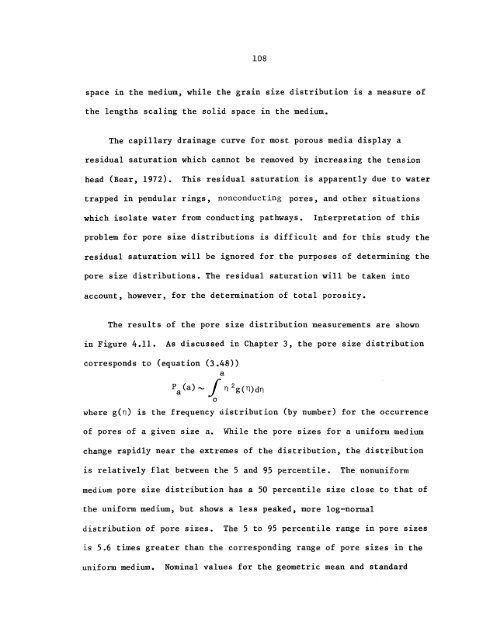longitudinal dispersion in nonuniform isotropic porous media
longitudinal dispersion in nonuniform isotropic porous media
longitudinal dispersion in nonuniform isotropic porous media
Create successful ePaper yourself
Turn your PDF publications into a flip-book with our unique Google optimized e-Paper software.
108<br />
space <strong>in</strong> the medium, while the gra<strong>in</strong> S1ze distribution is a measure of<br />
the lengths scal<strong>in</strong>g the solid space <strong>in</strong> the medium.<br />
The capillary dra<strong>in</strong>age curve for most <strong>porous</strong> <strong>media</strong> display a<br />
residual saturation which cannot be removed by <strong>in</strong>creas<strong>in</strong>g the tension<br />
head (Bear, 1972). This residual saturation is apparently due to water<br />
trapped <strong>in</strong> pendular r<strong>in</strong>gs, nonconduct<strong>in</strong>g pores, and other situations<br />
which isolate water from conduct<strong>in</strong>g pathways. Interpretation of this<br />
problem for pore size distributions is difficult and for this study the<br />
residual saturation will be ignored for the purposes of determ<strong>in</strong><strong>in</strong>g the<br />
pore size distributions. The residual saturation will be taken <strong>in</strong>to<br />
account, however, for the determ<strong>in</strong>ation of total porosity.<br />
The results of the pore S1ze distribution measurements are shown<br />
1n Figure 4.11. As discussed <strong>in</strong> Chapter 3, the pore size distribution<br />
corresponds to (equation (3.48»<br />
a<br />
P a (a) "" f n 2 g (n)dn<br />
o<br />
where g(n) is the frequency riistribution (by number) for the occurrence<br />
of pores of a given size a. While the pore sizes for a uniform medium<br />
change rapidly near the extremes of the distribution, the distribution<br />
is relatively flat between the 5 and 95 percentile. The <strong>nonuniform</strong><br />
medium pore size distribution has a 50 percentile size close to that of<br />
the uniform medium, but shows a less peaked, more log-normal<br />
distribution of pore sizes. The 5 to 95 percentile range <strong>in</strong> pore sizes<br />
1S 5.6 times greater than the correspond<strong>in</strong>g range of pore sizes <strong>in</strong> the<br />
uniform medium. Nom<strong>in</strong>al values for the geometric mean and standard

















